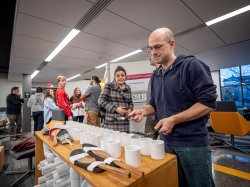Musical Numbers: Understanding How Math and Music Merge
In building a thongophone for mathematical analysis of its pipes for pitch, Montclair students find the connection between music and math
Posted in: Homepage News, Research, Science and Technology, Uncategorized, University

For anyone who believes math and music are an odd couple, Montclair State University Mathematics Professor Bogdan Nita may have you changing your tune. Nita conducts Mathematics and Music to teach students to see beyond formulas and to make connections by designing and building musical instruments to understand how musical elements can be analyzed numerically.
This semester, the class collaborated on studying a percussion instrument known as the thongophone. Built with recycled PVC pipes, the instrument produces a sound that varies according to the length of the pipes, one pipe per pitch arranged like the keyboard of a piano. It gets its name for the way it is played: The top of the pipes are struck with something flexible, like rubber thongs or flip-flops, the handiest things to use where the instrument originated in Australia and Papua New Guinea.
In building their own thongophone, the Math majors covered a wide variety of mathematical concepts – algebra, geometry, differential equations, a bit of topology and vector calculus – and all of it related to music. “You talk about algebra and suddenly you talk about scales and then how can you invent your own scale? We do complicated algebra and the students can’t tell because they’re captivated by the music,” Nita says.


The instrument and student research were displayed at the Math and Music Showcase presented on November 29 by the Department of Mathematics. “We studied how sound is created inside the pipes because of pressure, the different ways you can create that pressure and how the length of the pipes relate to the pitch that is produced,” Nita explains. “We wrote equations, we solved them, we looked at thongophones that already exist and we built our own that’s sort of like a pipe organ you play with thongs.”
The Mathematics and Music course was developed as part of a University effort to connect math and the general sciences with different areas of creativity, including art, architecture, poetry, painting and music, Nita says. The initiative includes the launching in 2023 of the LASER Journal, an open access, peer-reviewed, online journal dedicated to research at the interface of mathematics and arts. The journal gets its name from the acronym Linking Art and Science through Education and Research.

Mathematics and Music has also contributed research on new and innovative harp shapes, with Nita and mathematics students Cristina Carr and Vlad Nita contributing to an article published in July in the Journal of Humanistic Mathematics. In their article, titled “The Mathematics of the Harp: Modeling the Classical Instrument and Designing Futuristic Ones,” the research team shares how they analyzed and modeled the neck of the classical harp based on the length, tension and density of the strings.

Story by Staff Writer Marilyn Joyce Lehren. Photos by John J. LaRosa
You May Also Like:
Research team publishes article on the mathematics of a harp
